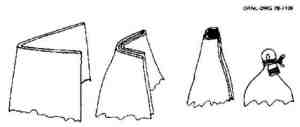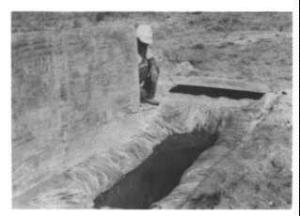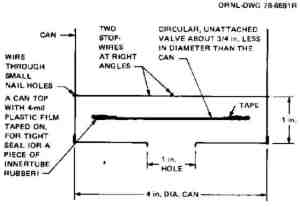************************************************************************
Rain Barrels will be a valuable source of water both for conservation/sustainability and for survival if the need arises. I have had a series of rain barrels that I have collected. A total of 12 – 30 gallon containers that will collect up to 360 gallons of water in a good downpour. As long as it rains I will have plenty of water to purify for drinking , bathing and cooking needs. Using t he greywater recovery technique I will also have plenty of water for my garden. It’s a win/win situation.
*************************************************************************
Rain Barrels will be a valuable source of water both for conservation/sustainability and for survival if the need arises. I have had a series of rain barrels that I have collected. A total of 12 – 30 gallon containers that will collect up to 360 gallons of water in a good downpour. As long as it rains I will have plenty of water to purify for drinking , bathing and cooking needs. Using t he greywater recovery technique I will also have plenty of water for my garden. It’s a win/win situation.
*************************************************************************
Harvesting Rainwater: How to Make a Rain Barrel
From harvesting rainwater in a rain barrel to composting your kitchen and yard waste in a compost bin, you can greatly increase your self-reliance by undertaking a few simple DIY projects.
By Betsy Matheson
May 12, 2011
May 12, 2011
Rainwater that is collected in a rain barrel before it hits the ground is free of many contaminants that water picks up as it filters through soil. This soft, warm (and free) water is perfect for plants, lawns, and many other outdoor applications. DIY Projects for the Self-Sufficient Homeowner provides a step-by-step plan to help you build a rain barrel, as well as many other DIY projects to increase your self-reliance.
COVER: CREATIVE PUBLISHING INTERNATIONAL
The following is an excerpt from DIY Projects for the Self-Sufficient Homeowner by Betsy Matheson (Creative Publishing International, 2011). This handy book is your first step toward participating in the fast-growing self-sufficiency movement. Even if you live on a small urban lot, you can take steps to gain a little more control over things you consume using the plans in this book. This excerpt is from Chapter 1, “Collecting Rainwater.”
Practically everything around your house that requires water loves the natural goodness that’s provided with soft rainwater. When you know how to make a rain barrel, you can begin harvesting rainwater to irrigate your garden or lawn, water your houseplants, or top off swimming pools and hot tubs. A ready supply of rainwater is also a reliable stand-by for emergency use if your primary water supply is interrupted.
Collecting rainwater runoff in rain barrels can save thousands of gallons of tap water each year. A typical 40-by- 40-foot roof is capable of collecting 1,000 gallons of water from only one inch of rain. A large rainwater collection system that squeezes every drop from your roof can provide most — or sometimes all — of the water used throughout the home, if it’s combined with large cisterns, pumps, and purification processing.
Sprinkling your lawn and garden can consume as much as 40 percent of the total household water use during the growing season. A simple rain barrel system that limits collected water to outdoor (nonpotable) use only, like the rain barrels described on the following pages, can have a big impact on the self-sufficiency of your home, helping you save on utility expenses and reducing the energy used to process and purify water for your lawn and garden. Some communities now offer subsidies for rain barrel use, offering free or reduced-price barrels and downspout connection kits. Check with your local water authority for more information. Get smart with your water usage, and take advantage of the abundant supply from above.
Collecting rainwater runoff in rain barrels can save thousands of gallons of tap water each year. A typical 40-by- 40-foot roof is capable of collecting 1,000 gallons of water from only one inch of rain. A large rainwater collection system that squeezes every drop from your roof can provide most — or sometimes all — of the water used throughout the home, if it’s combined with large cisterns, pumps, and purification processing.
Sprinkling your lawn and garden can consume as much as 40 percent of the total household water use during the growing season. A simple rain barrel system that limits collected water to outdoor (nonpotable) use only, like the rain barrels described on the following pages, can have a big impact on the self-sufficiency of your home, helping you save on utility expenses and reducing the energy used to process and purify water for your lawn and garden. Some communities now offer subsidies for rain barrel use, offering free or reduced-price barrels and downspout connection kits. Check with your local water authority for more information. Get smart with your water usage, and take advantage of the abundant supply from above.
Rain Barrels
Rain barrels, either built from scratch or purchased as a kit, are a great way to irrigate a lawn or garden without running up your utilities bill. The most common systems include one or more rain barrels (40 to 80 gallons) positioned below gutter downspouts to collect water runoff from the roof. A hose or drip irrigation line can be connected to spigot valves at the bottom of the rain barrel. You can use a single barrel, or connect several rain barrels in series to collect and dispense even more rainwater.
Plastic rain barrel kits are available for purchase at many home centers for around $100. If kit prices aren’t for you, a rain barrel is easy to make yourself for a fraction of the price. The most important component to your homemade barrel is the drum you choose.
A barrelful of water is an appealing breeding ground for mosquitoes and a perfect incubator for algae. Filters and screens over the barrel opening should prevent insect infestation, but for added protection against mosquitoes add one tablespoon of vegetable oil to the water in the barrel. This coats the top surface of the stored water and deprives the larvae of oxygen.
In addition to height, other issues surrounding the placement of your rain barrel (or rain barrels) include the need to provide a good base, orientation of the spigot and overflow, the position relative to your downspouts, and how to link more than one rain barrel together. Tip: Wherever possible, locate your rain barrel in a shaded area. Sunlight encourages algae growth, especially in barrels that are partially translucent.
Tools and Materials
Obtaining a Rain Barrel
Practically any large waterproof container can be used to make a rain barrel. One easily obtained candidate is a trash can, preferably plastic, with a snap-on lid. A standard 32-gallon can will work for a rain barrel, but if you can find a 44-gallon can choose it instead. Although wood barrels are becoming more scarce, you can still get them from wineries. A used 55-gallon barrel can be obtained free or for a small charge from a bulk food supplier. Most 55-gallon barrels today are plastic, but some metal barrels are still floating around. Whatever the material, make sure the barrel did not contain any chemical or compound that could be harmful to plants, animals, or humans. If you don’t know what was in it, don’t use it. Choose a barrel made out of opaque material that lets as little light through as possible, reducing the risk of algae growth.A barrelful of water is an appealing breeding ground for mosquitoes and a perfect incubator for algae. Filters and screens over the barrel opening should prevent insect infestation, but for added protection against mosquitoes add one tablespoon of vegetable oil to the water in the barrel. This coats the top surface of the stored water and deprives the larvae of oxygen.
How to Make a Rain Barrel
Tools and Materials- Barrel or trash can
- Drill with spade bit
- Jigsaw
- Hole saw
- Barb fitting with nut for overflow hose
- 1 1/2″ sump drain hose for overflow
- 3⁄4″ hose bibb or sillcock
- 3⁄4″ male pipe coupling
- 3⁄4″ bushing or bulkhead connector
- Channel-type pliers
- Fiberglass window screening
- Cargo strap with ratchet
- Teflon tape
- Silicone caulk
- Cut a large opening in the barrel top or lid. Mark the size and shape of your opening — if using a bulk food barrel, mark a large semi-circle in the top of the barrel. If using a plastic garbage can with a lid, mark a 12-inch diameter circle in the center of the lid. Drill a starter hole, and then cut out the shape with a jigsaw (see Image Gallery).
- Install the overflow hose. Drill a hole near the top of the barrel for the overflow fitting. Thread the barb fitting into the hole and secure it to the barrel on the inside with the retainer nut and rubber washer (if provided). Slide the overflow hose into the barbed end of the barb elbow until the end of the hose seats against the elbow flange (see Image Gallery).
- Drill the access hole for the spigot (either a hose bibb or sillcock, brass or PVC). Tighten the stem of the sillcock onto a threaded coupling inserted into the access hole. Inside the barrel, a rubber washer is slipped onto the coupling end and then a threaded bushing is tightened over the coupling to create a seal. Apply a strip of Teflon tape to all threaded parts before making each connection. Caulk around the spigot with clear silicone caulk.
- Screen over the opening in the top of the barrel. Lay a piece of fiberglass insect mesh over the top of the trash can and secure it around the rim with a cargo strap or bungee cord that can be drawn drum-tight. Snap the trash can lid over the top. Once you have installed the rain barrel, periodically remove and clean the mesh.
How to Install a Rain Barrel
Whether you purchase a rain barrel or make your own from scratch or a kit, how well it meets your needs will depend on where you put it and how it is set up (see Image Gallery). Some rain barrels are temporary holding tanks that store water runoff just long enough to direct it into your yard through a hose and drip irrigation head. Other rain barrels are more of a reservoir that supplies water on-demand by filling up watering cans or buckets. If you plan to use the spigot as the primary means for dispensing water, you’ll want to position the rain barrel well off the ground for easy access (raising your rain barrel has no effect on water pressure).In addition to height, other issues surrounding the placement of your rain barrel (or rain barrels) include the need to provide a good base, orientation of the spigot and overflow, the position relative to your downspouts, and how to link more than one rain barrel together. Tip: Wherever possible, locate your rain barrel in a shaded area. Sunlight encourages algae growth, especially in barrels that are partially translucent.
Tools and Materials
- Drill/driver
- Screwdriver
- Hack saw
- Rain barrel
- Hose & fittings
- Base material (pavers)
- Downspout adapter and extension
- Teflon tape
- Select a location for the barrel under a downspout. Locate your barrel as close to the area you want to irrigate as possible. Make sure the barrel has a stable, level base.
- Install the spigot. Some kits may include a second spigot for filling watering cans. Use Teflon tape at all threaded fittings to ensure a tight seal. Connect the overflow tube, and make sure it is pointed away from the foundation.
- Cut the downspout to length with a hacksaw. Reconnect the elbow fitting to the downspout using sheet-metal screws. Attach the cover to the top of the rain barrel. Some systems include a cover with porous wire mesh, to which the downspout delivers water. Others include a cover with a sealed connection (next step).
- Link the downspout elbow to the rain barrel with a length of flexible downspout extension attached to the elbow and the barrel cover. Variation: If your barrel comes with a downspout adapter, cut away a segment of downspout and insert the adapter so it diverts water into the barrel.
- Connect a drip irrigation tube or garden hose to the spigot. A Y-fitting will let you feed the drip irrigation system through a garden hose when the rain barrel is empty.
- If you want, increase water storage by connecting two or more rain barrels together with a linking kit, available from many kit suppliers.
Reprinted with permission from DIY Projects for the Self-Sufficient Homeowner, published by Creative Publishing International, 2011.













